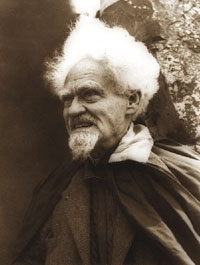 Wicca (English: /ˈwɪkə/), also termed Pagan Witchcraft, is a contemporary Pagan new religious movement. It was developed in England during the first half of the 20th century and was introduced to the public in 1954 by Gerald Gardner, a retired British civil servant. Wicca draws upon a diverse set of ancient pagan and 20th-century hermetic motifs for its theological structure and ritual practices.
Wicca (English: /ˈwɪkə/), also termed Pagan Witchcraft, is a contemporary Pagan new religious movement. It was developed in England during the first half of the 20th century and was introduced to the public in 1954 by Gerald Gardner, a retired British civil servant. Wicca draws upon a diverse set of ancient pagan and 20th-century hermetic motifs for its theological structure and ritual practices.
Wicca has no central authority. Its traditional core beliefs, principles and practices were originally outlined in the 1940s and 1950s by Gardner and Doreen Valiente, both in published books as well as in secret written and oral teachings passed along to their initiates. There are many variations on the core structure, and the religion grows and evolves over time. It is divided into a number of diverse lineages, sects and denominations, referred to as traditions, each with its own organisational structure and level of centralisation. Due to its decentralized nature, there is some disagreement over what actually constitutes Wicca. Some traditions, collectively referred to as British Traditional Wicca, strictly follow the initiatory lineage of Gardner and consider the term Wicca to apply only to similar traditions, but not to newer, eclectic traditions.
Wicca is typically duotheistic, worshipping a Goddess and a God. These are traditionally viewed as the Moon Goddess and the Horned God, respectively. These deities may be regarded in a henotheistic way, as having many different divine aspects which can in turn be identified with many diverse pagan deities from different historical pantheons. For this reason, they are sometimes referred to as the "Great Goddess" and the "Great Horned God", with the adjective "great" connoting a deity that contains many other deities within their own nature. These two deities are sometimes viewed as facets of a greater pantheisticdivinity, which is regarded as an impersonal force or process rather than a personal deity. While duotheism or bitheism is traditional in Wicca, broader Wiccan beliefs range from polytheism to pantheism or monism, even to Goddess monotheism.
Wiccan celebrations encompass both the cycles of the Moon, known as Esbats and commonly associated with the Goddess (female deity), and the cycles of the Sun, seasonally based festivals known as Sabbats and commonly associated with the Horned God (male deity). An unattributed statement known as the Wiccan Rede is a popular expression of Wiccan morality, although it is not universally accepted by Wiccans. Wicca often involves the ritual practice of magic, though it is not always necessary.
------------------------------------------------------------------------------------------------
 Gerald Brosseau Gardner (1884 – 1964), also known by the craft name Scire, was an English Wiccan, as well as an author and an amateur anthropologist and archaeologist. He was instrumental in bringing the Contemporary Pagan religion of Wicca to public attention, writing some of its definitive religious texts and founding the tradition of Gardnerian Wicca.
Gerald Brosseau Gardner (1884 – 1964), also known by the craft name Scire, was an English Wiccan, as well as an author and an amateur anthropologist and archaeologist. He was instrumental in bringing the Contemporary Pagan religion of Wicca to public attention, writing some of its definitive religious texts and founding the tradition of Gardnerian Wicca.
Born into an upper-middle-class family in Blundellsands, Lancashire, Gardner spent much of his childhood abroad in Madeira. In 1900, he moved to colonial Ceylon, and then in 1911 to Malaya, where he worked as a civil servant, independently developing an interest in the native peoples and writing papers and a book about their magical practices. After his retirement in 1936, he travelled to Cyprus, penning the novel A Goddess Arrives before returning to England. Settling down near the New Forest, he joined an occult group, the Rosicrucian Order Crotona Fellowship, through which he claimed to have encountered the New Forest coveninto which he was initiated in 1939. Believing the coven to be a survival of the pre-Christian Witch-Cultdiscussed in the works of Margaret Murray, he decided to revive the faith, supplementing the coven's rituals with ideas borrowed from Freemasonry, ceremonial magic and the writings of Aleister Crowley to form the Gardnerian tradition of Wicca.
Moving to London in 1945, following the repeal of the Witchcraft Act of 1736 he became intent on propagating this religion, attracting media attention and writing about it in High Magic's Aid (1949), Witchcraft Today (1954) and The Meaning of Witchcraft (1959). Founding a Wiccan group known as the Bricket Wood coven, he introduced a string of High Priestesses into the religion, including Doreen Valiente, Lois Bourne, Patricia Crowther and Eleanor Bone, through which the Gardnerian community spread throughout Britain and subsequently into Australia and the United States in the late 1950s and early 1960s. Involved for a time with Cecil Williamson, Gardner also became director of the Museum of Magic and Witchcraft on the Isle of Man, which he ran until his death.
Gardner is internationally recognised as the "Father of Wicca" among the Pagan and occult communities. His claims regarding the New Forest coven have been widely scrutinised, with Gardner being the subject of investigation for historians and biographers such as Aidan Kelly, Ronald Hutton and Philip Heselton.




